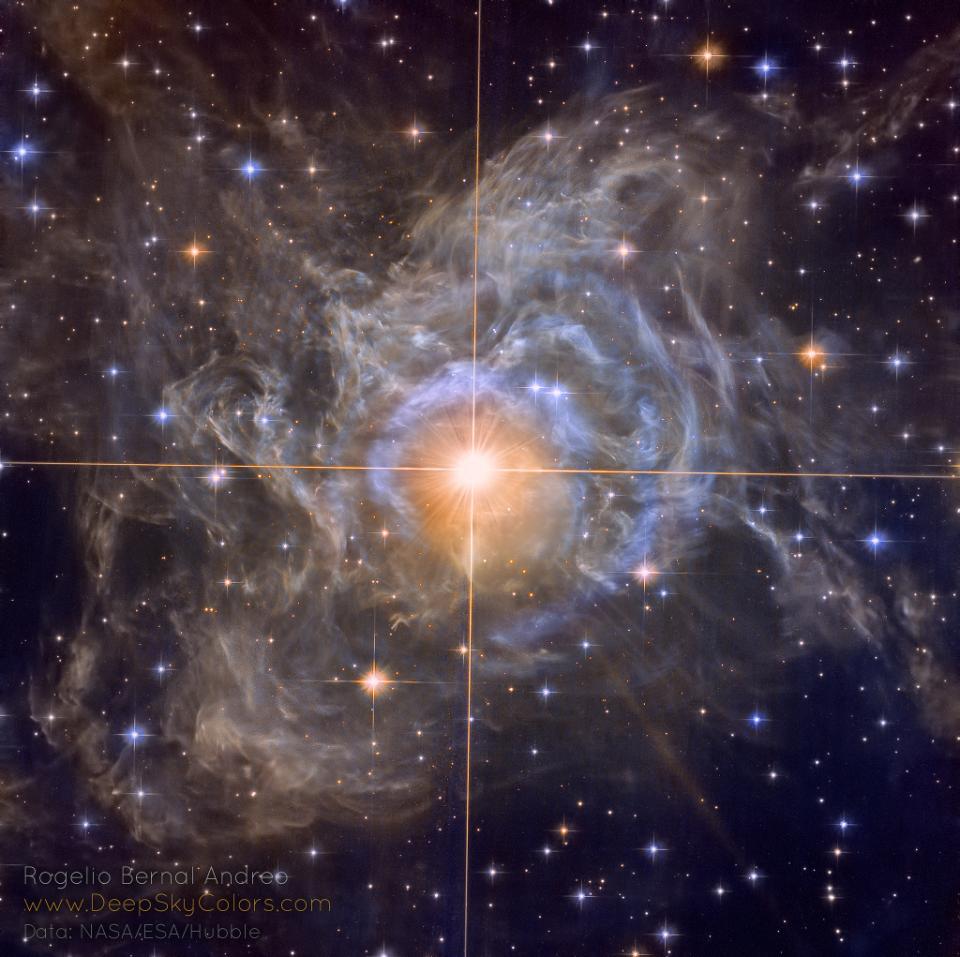Puppis

Puppis is the stern of what was once the much larger constellation of The Argo – the ship Jason sailed in Greek mythology. The French astronomer Nicolas Louis de Lacaille divided up the original constellation (as documented in Ptolomy’s Amalgest) in 1752 to the parts of the ship – the keel – Carina, the sail, Vela and Puppis.
Named stars in order of brightness;
https://www.chandra.si.edu/photo/2014/puppisa/
https://chandra.harvard.edu/photo/2007/puppis/ – Cannon Ball Neutron star
Puppis belongs to the Heavenly Waters family of constellations, along with Carina, Columba, Delphinus, Equuleus, Eridanus, Piscis Austrinus, Pyxis, and Vela.
Pulsating RS Puppis, the brightest star in the image center, is some ten times more massive than our Sun and on average 15,000 times more luminous. In fact, RS Pup is a Cepheid variable star, a class of stars whose brightness is used to estimate distances to nearby galaxies as one of the first steps in establishing the cosmic distance scale. As RS Pup pulsates over a period of about 40 days, its regular changes in brightness are also seen along its surrounding nebula delayed in time, effectively a light echo. Using measurements of the time delay and angular size of the nebula, the known speed of light allows astronomers to geometrically determine the distance to RS Pup to be 6,500 light-years, with a remarkably small error of plus or minus 90 light-years. An impressive achievement for stellar astronomy, the echo-measured distance also more accurately establishes the true brightness of RS Pup, and by extension other Cepheid stars, improving the knowledge of distances to galaxies beyond the Milky Way.
Image Credit & Copyright: Image Data: NASA, ESA, Hubble Legacy Archive;
Processing & Copyright: Rogelio Bernal Andreo (DeepSkyColors.com)
https://science.nasa.gov/rs-puppis

Pyxis

α Pyxidis (Alpha Pyxidis)
Alpha Pyxidis is a giant star of the spectral type B1.5III. It has an apparent magnitude of 3.67 and is approximately 880 light years distant. The star is classified as a Beta Cephei variable, which means that variations in its brightness are a result of pulsations of the star’s surface.
Alpha Pyxidis has more than 10 solar masses and a radius six times that of the Sun. It is about 10,000 times more luminous than the Sun and will eventually end its life as a supernova.
T Pyxidis
T Pyxidis is a binary star composed of a star similar to the Sun and a white dwarf. It usually has a visual magnitude of 15.5, but being a recurrent nova, when it erupts, the magnitude can go up to 6.4. There are currently only ten recurrent novae known. T Pyxidis was observed erupting in 1890, 1902, 1920, 1944, 1966 and 2011.
The two stars in the T Pyxidis system lie close together and the white dwarf draws mass off the Sun-like star, which causes the periodic eruptions.
T Pyxidis is at least about 10,388 light years (3,185 parsecs) distant from Earth. Evidence suggests that the star has increased in mass despite the eruptions and that it might soon end its life as a Type 1a supernova, the kind that occurs when a white dwarf in a binary system reignites and triggers a supernova event. T Pyxidis is expected to go supernova at some point in the next 10 million years. The event will likely not affect life on Earth because star is too distant for the supernova to significantly damage our ozone layer.
NGC 2818

Image Credit: NASA, ESA, Hubble Heritage Team (STScI / AURA) https://apod.nasa.gov/apod/ap140713.html
Vela

Vela constellation lies in the southern hemisphere. Its name means “the sails” in Latin. The constellation represents the sails of the Argo Navis, the ship on which Jason and the Argonauts sailed on their quest for the Golden Fleece. It was once part of the much larger constellation Argo Navis, which was divided into three smaller constellations – Vela (the sails), Carina (the keel) and Puppis (the stern) – by the French astronomer Nicolas Louis de Lacaille in the 1750s.
Argo Navis was one of the 48 Greek constellations, first catalogued by the Greek astronomer Claudius Ptolemy in the 2nd century CE.
Vela contains a number of interesting stars and deep sky objects, among them the Eight-Burst Nebula (NGC 3132), the Gum Nebula, the Vela Supernova Remnant, the Pencil Nebula (NGC 2736), and the Omicron Velorum Cluster (IC 2391). Constellation guide
NGC 3132; Eight-Burst Nebula (Southern Ring Nebula)

NGC 3132 is a bright planetary nebula in Vela, almost half a light year in diameter. It has an apparent magnitude of 9.87 and is approximately 2,000 light years distant from the Sun. It was named the Eight-Burst Nebula because it appears like the figure 8 in amateur telescopes.
The nebula contains two stars, a 10th magnitude star and a 16th magnitude white dwarf which has blown off its outer layers and whose ultraviolet radiation makes the nebula glow. Constellation guide
